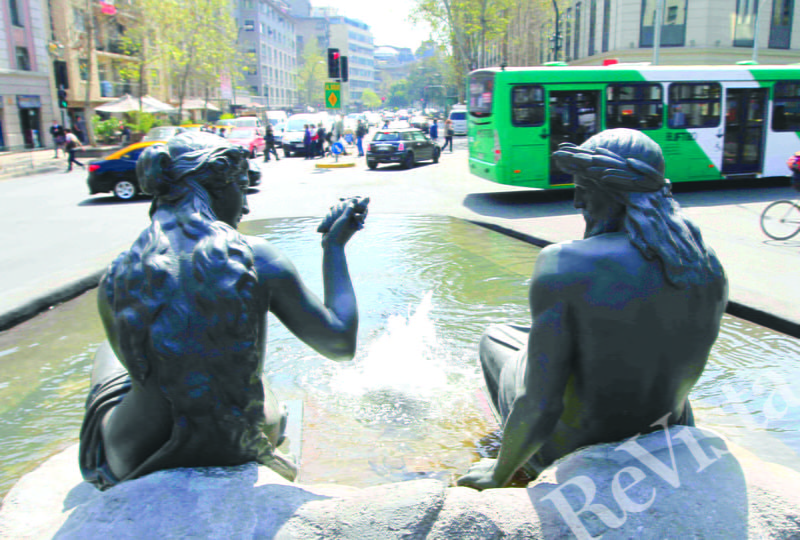Living with Landscapes
The Primacy of Nature
In many places in America, Asia and Europe, your doctor just might pen a “park prescription” urging green space use or send you to a “forest bathing” spa that touts nature’s health benefits. Yet in Central and South America, despite the strong presence of eco-tourism, the targeted use of time in nature as a complimentary therapy to improve health seems less common. While this may reflect different attitudes towards the environment, healthcare, development or disease transmission (e.g. Zika), it also represents a missed opportunity.
Humans have evolved through adaption to their surroundings; cities are both relatively recent and often somewhat stressful. We can attempt to create more soothing “habitat” for modern populations through the incorporation of natural design cues such as exposed wood, stone and water in the built environment. Cities provide an abstract reflection of what we know about where we are and how we came to be. The character of the land shapes inhabitants through climate, structure, materials, sustenance and spirit.
Psychoanalyst Erich Fromm and later Harvard biologist E.O. Wilson developed the term biophilia to capture the “innate tendency to focus on life and lifelike processes” (Wilson, 1984). As Stephen Kellert writes, “the successful application of biophilic design fundamentally depends on adopting a new consciousness toward nature, recognizing how much our physical and mental wellbeing continues to rely on the quality of our connections to the world beyond ourselves of which we still remain a part” (Kellert, 2015). Honoring our reliance on nature as resource and refuge is critical in an era of volatile social, economic and environmental change; accordingly, cultural resilience is firmly rooted in the natural characteristics of place. Biophilia thus bridges urban form and local biome—the naturally occurring community of flora and fauna such as a forest or tundra. It provides language and practice through which we situate our experience of “place” through nature.
What kinds of green matter, to whom, and under what circumstances? Research suggests that higher levels of green vegetation offer real benefits to human health in the form of decreased mortality rates, improved opportunities for physical activity, reductions in exposure to harmful environmental pollutants, increased social engagement and improved mental health. Tools like the US Forest Service’s iTree can be used to help quantify the contribution of urban canopies to metrics that influence health like air pollution reduction, carbon sequestration, decreases in ambient temperature and improvements to adjacent building energy efficiency. We are still learning about the more subtle environmental features that support wellbeing; urban planners, landscape architects and public health officials are exploring how to compose a scene or vista that is maximally “effective” (defined, in this case, as a natural setting that evokes positive physiological and psychological responses in most viewers). Most empirical research has been conducted in Asia (Japan, Taiwan, Korea) and the West (Europe, Australia, and the United States), but the eco-reserves of Latin America provide potential sites for compelling investigations into the influence of culture on environmental preferences.
Environmental preferences arise from a variety of interconnected factors. We are, first and foremost, bound by our bodies; five primal senses (sight, hearing, touch, smell and taste) orchestrate our experience. It is important to remember that other cultures don’t necessarily divide the sensorium along these lines. Many sensory assessments occur at an unconscious or semi-conscious level, providing a quick appraisal of the landscape for attributes that would contribute to a sense of safety and well being. An indigenous healer in Peru, for instance, referred in the 1978 book Wizard of Four Winds to “a sixth clairvoyant sense [that] opens up when all five other senses have been stimulated through the use of hallucinogens and other ritual elements,” providing visions of things that have happened in the past or may happen in the future. Culture often privileges one or more sensory pathways. Indigenous Australians, for instance, navigate long distances via “songlines” that detail landscape through language, rhythm and melodic contour; without the benefit of written language, sound assumes primacy. Chemoreceptors detect blood-borne hormones and drugs, including bioactive aerosols called phytoncides that are released by trees and credited with reductions in blood pressure, improvements in mood, and increases in natural killer “T” cells. The modern practice of “Forest Bathing” in Japan relies on this paradigm, suggesting that hikers are literally bathed in compounds that promote health and well-being (“salutogenic”) just as they might be in a more traditional “onsen” or mountain hot spring. Magnetoceptors detect magnetic fields, which is principally useful in guiding migratory routes that rely on the Earth’s magnetic field but may also provoke responses in people to geological substrata. Most Balinese, for instance, sleep with their heads towards northeast where the sacred Mount Agung lies; this orientation is called kaja (versus kelod, towards the sea). The primacy of landscape is so great that people who lose their sense of direction are said to have lost their minds. These examples of synergies between sensory faculties and landscape features underscore how culture, language and belief shape our physical experience of the environment. Further interpretation often focuses on gross structural features (depth, prospect, intensity of color, variety of texture, presence of trees, flowers or water) or mathematical patterns in nature (fractals, Fibonacci sequences) that make some types of plants or scenes more easily intelligible and, the logic goes, appealing. Preferences also change based on age, gender and physical health. But it would be folly to render landscape preference as so rooted in evolution, biology or even mathematics that it escapes the strong influence of culture. Indeed, while we may be primed for biophilia, the expression of our affinity for nature is situated in our lives as individuals embedded in a cultural context.
The use of water is a common biophilic design feature with cross-cultural appeal that can provide sensory refuge and restoration in cities. Water’s many incarnations—ocean, river, creek, pond, wetland, marsh, vernal pool, brook, bay, estuary, dew, cloud, rain, mist, humidity, sleet, snow, rainbow and fog—are critical for sustaining life (ours as well as flora and fauna that we depend on for survival) and provide soothing sensory cues (ambient humidity, refracted light, the sensation of the passage of time). Early cities used fountains or pumps in communal areas to supply water for drinking, cooking and bathing; the legacy of Spanish or Portuguese plazas, generally abutting cathedrals or missions, remains in the older districts of Latin American cities today. The sound of moving water is thought to be fractal in nature, with “regular irregularities” that effortlessly engage and soothe the mind through rhythmicity and complexity. The dominant sound produced by water stems from vibrating bubbles. Bubble size determines resonant frequency, with bubbles from 1.5 to 150mm producing sounds within the 20-20,000Hz range that is audible for humans. Complex natural sources such as steams, pouring water, rivers, rain and breaking waves generate huge quantities of bubbles and a statistical approach is required to model the sounds produced. The ideal urban water noise would both mask disruptive low frequency noise (from traffic) and restore a sense of tranquility; curiously, the relative tranquility of a water sound intervention has more to do with its character (tonal frequency) or physical presence than with its capacity to obscure the noise of surrounding traffic.
But sound is never just sound. In fact, all sound is received in the auditory cortex, encoded in multiple spectrograms with different degrees of spectral and temporal resolution, and stored as multi-resolution “topographic maps.” This spatial representation of sound is referred to as the ‘tonotopy’ of sound. Specialization of different cortical fields that process natural sounds rely on the tradeoff between spectral and temporal precision; different “views” of the spectrogram may be preferable for different goal-oriented behaviors (hunting versus foraging, for instance). One unexplored dimension of spectrograms is what role (if any) the neural basis for shape preference may play in tonotopy and environmental affinity. Curves, non-parallel contours and fractals have well-established appeal visually. Curves and contours elicit higher neural activity and attract eye movements more so than straight contours (with 0 curvatures or parallel contours with 0 angles of convergence) (Amir 2011), while fractals with an order of complexity between 1.3-1.8 (e.g. the branching structure found in the Acacia tree) are most compelling and, potentially, restorative (Ryan 2014). We also understand that experience of sound has a shape: beyond neurobiological spectrograms, a babbling brook might be fractal, a rolling wave parabolic, and wind tidal. The interface between the shape perceived visually, heard sensorially, interpreted and encoded neurologically provides a realm wherein design plays a critical if poorly characterized part. When considering the importance of tonotopy—that is, how sound is systematically represented in the brain, and how sound perception then contributes to interpretation of visual cues in a dynamic feedback loop—I am not aware of research which uses fMRI or EEG technology to demonstrate how sounds (natural or otherwise) can be used to shift the “mapping” of dense, sensorially crowded spaces into something more spacious or comfortable. To the extent that the introduction of natural sounds triggers favorable memories or associative frameworks of embodied experience that counter the immediate surroundings through distraction, displacement, or masking, they may favorably improve the dynamic impression of physical comfort and space in cities.
Although waves breaking on a beach and cars moving on a freeway have similar spectral and temporal characteristics perceived as a “constant roar,” visual input determines their reception. In one study (Watts, 2009), researchers logarithmically averaged a 65dBA audio track that merged recordings of a freeway and beach respectively and then used fMRI data to assess neural responses to two scenes that shared the same audio track (beach and freeway merged) but were visually distinct (beach vs. freeway) and considered tranquil (beach) vs. non-tranquil (freeway). Under identical auditory but different visual input circumstances, the authors used “effective connectivity” as a primary outcome, analyzing the degree of connectivity between the auditory cortex and other areas of the brain as a marker of integrated (sensory, cognitive and affective) perceptual experience. They found that a tranquil visual input (beach image) with sound enhanced audio-cortical connectivity whereas the non-tranquil condition (freeway) with sound resulted in reduced auditory thalamo-cortical connectivity. Here we see that the thalamus acts as a protective “filter” for audiovisual integration, acting as a “gatekeeper” in early cross-modal interactions and down-regulating attributions perceived as stressful. Enhanced perceptual connectivity is related to perceived congruence between visual and auditory cues, suggesting that the synergies embedded in a biophilic design environment is partially modulated in early stages by the auditory cortex. For urban planners, the impact of this finding is clear: in settings with stressful auditory input (in this example, traffic noise), the use of natural features can help mitigate the sensory burden on residents, but the soothing sound of water is most effective if it is also paired with the sight of “natural” water (in this example, an ocean). A fountain in a plaza, encased in ornately carved cement and populated by school- children’s boats or spare change cast hopefully into the shallows, may not be enough. To design well with water, we can look towards the recent trend of uncovering and restoring buried streams and rivers in cities. These infrastructure projects are notionally concerned with restoring the native hydrology of a place to improve resilience when facing floods or counteract subsidence, but their benefits—when coupled with the potential for providing critical wildlife corridors— extend to the health and wellbeing of surrounding residents. Indeed, this vision of biophilic design progressively integrates the layered needs of the land, the city and the individual, arriving at a compromise that is more equitable and healthy for all concerned.
Fall 2016, Volume XVI, Number 1
Julia Africa leads the ecological infrastructure, biophilic design and restorative landscape areas of the Nature and Health program at the Harvard T.H. Chan School of Public Health’s Center for Health and the Global Environment.
Related Articles
Cacao Biology
Cacao, a tree whose seeds people use to make chocolate, has long been a way for people to understand the world. For pre- Columbian Mesoamericans, cacao linked people to each other, the plants, animals and places around them, and to the divine, the environment seen…
Volunteering for a Cause
What happens when researchers look quite simply for “other ways of telling the story?” Silvia Marina Arrom asks this question at the beginning of her deeply researched history of the male…
La danza hostil
La danza hostil revisits an age-old question in political science: how is political power constructed (and re-constructed)? Alberto Vergara tackles this question by examining…





